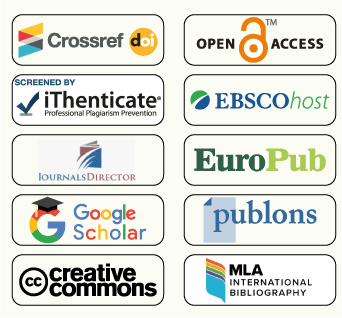Multimodal analysis of film and video production: reviewing the field
Abstract
It has been found that the literature on film analysis primarily contains four proposed attempts at applying multimodal terms, techniques, and procedures to film and video production: O’Halloran (2004), Tan (2009), Baldry and Thibault (2006), and Bateman (2008, 2012). The core insight and principle these four models share is how semiotic resources or choices are combined together and interact to produce meaning. They all emphasise, each to their own, that semiotic resources, or modes are organised into a hierarchy of systems, planes, strata, or taxonomies where semiotic features can be identified, classified, and analysed to form patterns and connections that ultimately lead to a better understanding and interpretation of multimodal phenomena. In addition, they highlight the importance of global coherence, and how it is achieved through the repeated co-deployment of semiotic modes to form patterns in dynamic texts. The four frameworks touch upon the notion of genre, and how patterns of intersemiotic relations can be instrumental in identifying genres. Finally, they point out that the construction of meaning in dynamic texts is impacted by how the text unfolds in real time.
Keywords: Multimodal analysis; Film analysis
Received on: 11 November 2024
Accepted on: 19 December 2024
Published on: 06 April 2025
Keywords
Full Text:
PDFReferences
Baldry, Anthony, and Paul J Thibault. Multimodal Transcription and Text Analysis A Multimodal Toolkit and Coursebook. David Brown Book Company, 2006.
Bateman, John. “Critical Discourse Analysis and Film.” In The Routledge Handbook of Critical Discourse Studies, edited by John Flowerdew and John E. Richardson, 612–25. Routledge, 2017. https://doi.org/10.4324/9781315739342.
Bateman, John. “Looking for What Counts in Film Analysis: A Programme of Empirical Research.” In Visual Communication, edited by David Machin, 365–69. DE GRUYTER, 2014. https://doi.org/10.1515/9783110255492.
Bateman, John. “The Decomposability of Semiotic Modes.” In Multimodal Studies: Multiple Approaches and Domains, edited by Kay O’Halloran and Bradley Smith, 17–38. Routledge, 2012. https://doi.org/10.4324/9780203828847.
Bateman, John A. “Multimodal Analysis of Film within the Gem Framework.” Ilha Do Desterro A Journal of English Language, Literatures in English and Cultural Studies 0, no. 64 (July 25, 2013). https://doi.org/10.5007/2175-8026.2013n64p49.
———. “Multimodal Cohesion and Text-Image Relations.” In Text and Image: A Critical Introduction Visual/Verbal Divide, John Bateman., 161–74. Routledge, 2014. https://doi.org/10.4324/9781315773971.
———. Multimodality and Genre: A Foundation for the Systematic Analysis of Multimodal Documents. Multimodality and Genre: A Foundation for the Systematic Analysis of Multimodal Documents, 2008. https://doi.org/10.1057/9780230582323.
———. “Text-Image Relations and Empirical MethodsText and Image.” In Text and Image: A Critical Introduction Visual/Verbal Divide, 239–50. Routledge, 2014. https://doi.org/10.4324/9781315773971.
Bateman, John, and Karl-Heinrich Schmidt. Multimodal Film Analysis. Routledge, 2013. https://doi.org/10.4324/9780203128220.
Bateman, John, Janina Wildfeuer, and Tuomo Hiippala. “Film and the Moving Audio-Visual Image.” In Multimodality, edited by John Bateman, Janina Wildfeuer, and Tuomo Hiippala, 327–39. De Gruyter, 2017. https://doi.org/10.1515/9783110479898.
Forceville, Ch.J. “Multimodal Transcription and Text Analysis: A Multimedia Toolkit and Coursebook.” Journal of Pragmatics 39, no. 6 (June 2007): 1235–38. https://doi.org/10.1016/j.pragma.2007.02.007.
O’Halloran, Kay L. “Multimodal Discourse Analysis.” In In Continuum Companion to Discourse Analysis, edited by Ken Hayland and Brian Paltridge, 120–37. Continuum, 2011.
O’Halloran, Kay L. Multimodal Discourse Analysis: Systemic-Functional Perspectives. Multimodal Discourse Analysis: Systemic-Functional Perspectives, 2004.
Smith, Bradley A., Sabine Tan, Alexey Podlasov, and Kay L. O’Halloran. “Analysing Multimodality in an Interactive Digital Environment: Software as a Meta-Semiotic Tool.” Social Semiotics 21, no. 3 (June 2011): 359–80. https://doi.org/10.1080/10350330.2011.564386.
Tan, Sabin. “A Systemic Functional Framework for the Analysis of Corporate Television Advertisements.” In In The World Told and the World Shown: Multisemiotic Issues, edited by Eija Ventola and Arsenio Jesús Moya Guijarro, 157–82. Basingstoke: Palgrave Macmillan, 2009. https://doi.org/10.1057/9780230245341.
DOI: http://dx.doi.org/10.21622/ILCC.2025.05.1.1087
Refbacks
- There are currently no refbacks.
Copyright (c) 2025 Marwa Mohamed Abd Allah, Marwa Mohamed Khamis El-Zouka, Abeer M. Refky M. Seddeek

This work is licensed under a Creative Commons Attribution-NonCommercial 4.0 International License.
Insights into Language, Culture and Communication
E-ISSN: 2812-491X
P-ISSN: 2812-4901
Published by:
Academy Publishing Center (APC)
Arab Academy for Science, Technology and Maritime Transport (AASTMT)
Alexandria, Egypt
ilcc@aast.edu

